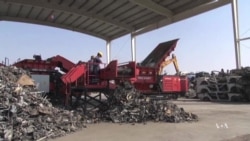According to the Environmental Protection Agency, the United States throws 14.8 million tons of scrap metal into landfills every year. One of the main reasons is the difficulty of large-scale separation of non-ferrous metals. Scientists at the University of Utah now say they have solved that problem.
Recycling metals is much cheaper than extracting them from the ore. But chopping up old cars, appliances or industrial equipment results in a mixture of different metal parts.
Iron and steel are easily separated with strong magnets, while others, such as copper, aluminum and titanium, either end up in landfills or are shipped to countries with cheap labor to pick out the different metal by hand.
Researchers at the University of Utah now say they have developed a method for mechanically separating light metals with high degree of accuracy.
Don Eggert of O2M Technologies, which partnered with the school in developing the technology, said the system is based on the fact that all metals react to a strong magnetic field.
“When the metal falls through the field, even it’s non-ferrous, it’s not attracted to the magnet, but the magnet causes there to be an electric current inside the metal and that causes the metal to have a magnetic field itself, which interacts with the magnetic field that it’s falling through and pushes it to the side,” said Eggert.
Eggert said rapid change in the frequency of the magnetic field results in metal pieces falling into different bins.
“So, for example, if we want to separate aluminum and copper we hit the right frequency for it and the aluminum would push more away from the magnet than the copper will," he said. "So the copper falls straight down, the aluminum falls into a different bucket.”
This is just one of the technologies for separating different metals but Eggert says it is much cheaper to build since it requires only one large circular magnet and a frequency controller.
“What we have calculated so far is that the expense to value ratio -- that is how quickly you can pay back the cost of the technology over time - we’re currently estimating it to be less than one year.”
At the moment, the separator works only with pellets up to one centimeter wide. Researchers are now building a bigger magnet with a wider cut to accommodate larger metal parts. They hope to have it installed at a metal shredding facility sometime this year, where they will be able to test it in a real-life environment.









